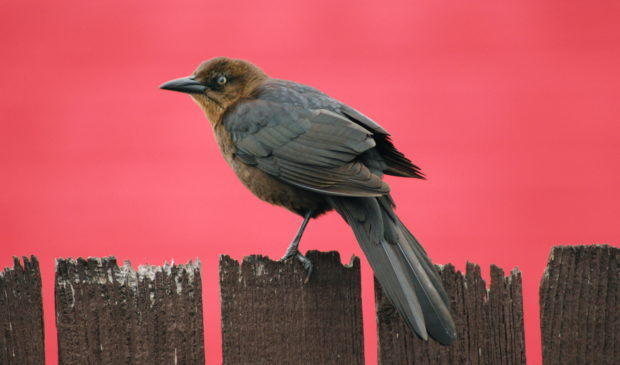Audubon Society recommends strategies to reduce bird deaths in Austin
Friday, November 8, 2019 by
Katherine Corley At Wednesday’s meeting of the Environmental Commission, Christy Esmahan, a member of the Travis Audubon Board of Directors, reported that nearly 30 percent of North America’s bird population has vanished in the last 50 years, per a September 2019 study in the journal Science. Texas hosts the widest variety of bird species in the nation, Esmahan said. During her presentation, she described the major threats posed to birds by buildings and urban light pollution and offered some strategies to help Austin become more bird-friendly.
Striking glass windows is one of the top three killers of birds.
“The biggest problem is that glass is invisible,” Esmahan said, which can create problems for humans as well as for birds. For example, when Apple opened its $5 billion, glass-enclosed campus in Silicon Valley in early 2018, multiple staff members were injured after walking into the glass windows, requiring Apple to use stickers to make the glass more visible.
Birds, of course, move much faster than humans and are often critically injured after colliding with glass. At least half of all bird strikes end in death, Esmahan said. In the United States, up to 1 billion birds die each year from hitting the glass windows of homes and office buildings.
“Unlike natural predators that are killing birds, glass collisions kill indiscriminately,” Esmahan said. “(The collisions) are killing the strong, the healthy, and the ones that should be putting their genes into the gene pool instead of just the weak and the sick and the extremely young.”
Another deadly problem with glass is its ability to reflect the surroundings, particularly foliage or sky. Buildings that sit very close to greenery are particularly dangerous, Esmahan said. Birds can’t distinguish reflections from reality, and will fly directly into a window reflecting the clouds, the sky or trees.
Texas is part of the Central Flyway, a major bird migratory route stretching through the middle of North America that is traveled by nearly 400 bird species. Most songbirds migrate at night so the stars can guide them, but urban light pollution disorients them, which often causes them to stop over in cities, Esmahan said, increasing their chance of striking a building.
Esmahan recommended a two-pronged solution for solving the threats buildings pose to birds.
Making glass less hazardous to birds is the first priority. To combat reflectivity, Esmahan suggested that all buildings use glass that reflects less than 15 percent of light. Esmahan also recommended either etching patterns or placing a patterned film on glass to make the glass more visible; patterns that cover as little as 5 percent of glass can reduce bird strikes by 90 percent, she said. Other options include using opaque, stained or frosted glass that is less transparent, or placing awnings over recessed glass. Several types of attractive, inexpensive decals can also be very effective for making windows more visible to birds.
“In my bedroom window, I was getting bird strikes once every six months, but that still … adds up.” Esmahan said. “So I hung little beads spaced every two inches. They’re glass, they shine and they’re pretty, but in the last two and a half years I have had zero bird strikes, no longer have to clean the windows, nor do I have to feel guilty about having this beautiful view of Austin that’s killing little birds.”
Next, she encouraged prioritizing dark skies by reducing individual and corporate light pollution through the Audubon Society’s Lights Out program guidelines.
“On an individual level, closing curtains and shades after dark is really important, whether you live in a house or a high-rise building, and using motion detectors for outdoor lighting rather than leaving your porch light or your garage light on all night long,” Esmahan said.
She also recommended that all office building lights be set on a timer to turn off the lights around 10 p.m., and that parking lot lights be operated through motion sensors instead of shining constantly.
Cities including New York; Chicago; Portland, Oregon; Houston; San Francisco; and Washington, D.C., have all instituted bird-friendly regulations. Esmahan urged the Environmental Commission to consider instituting similar laws and guidelines in Austin that incorporate the LEED standards for bird collision deterrence. She also recommended that new buildings have less than 45 percent glass on the outer facade.
In a conversation with the Austin Monitor, Environmental Officer Chris Herrington said Austin’s zoning code does have some “dark sky friendly” lighting design criteria for certain types of development that is meant to reduce light pollution.
However, Herrington said that Austin currently does not have regulations to prevent bird strikes as recommended by the Audubon Society, and stated that the city is still in the information-gathering phase.
“As the environmental officer, (I) found a lot of the recommendations that (Audubon) provided helpful, and that’s something that we will be considering in conversations with future planned unit development applications and potentially as a recommendation for a new policy for Council consideration,” Herrington said.
“Now we need to hear from some of the other stakeholders, like the development community, as to the best means to implement this,” Herrington continued. “This conversation is, from my perspective, new to the community. I haven’t heard it before, so I was happy to hear it last night.”
Photo by Stephen Downes made available through a Creative Commons license.
The Austin Monitor’s work is made possible by donations from the community. Though our reporting covers donors from time to time, we are careful to keep business and editorial efforts separate while maintaining transparency. A complete list of donors is available here, and our code of ethics is explained here.
You're a community leader
And we’re honored you look to us for serious, in-depth news. You know a strong community needs local and dedicated watchdog reporting. We’re here for you and that won’t change. Now will you take the powerful next step and support our nonprofit news organization?






